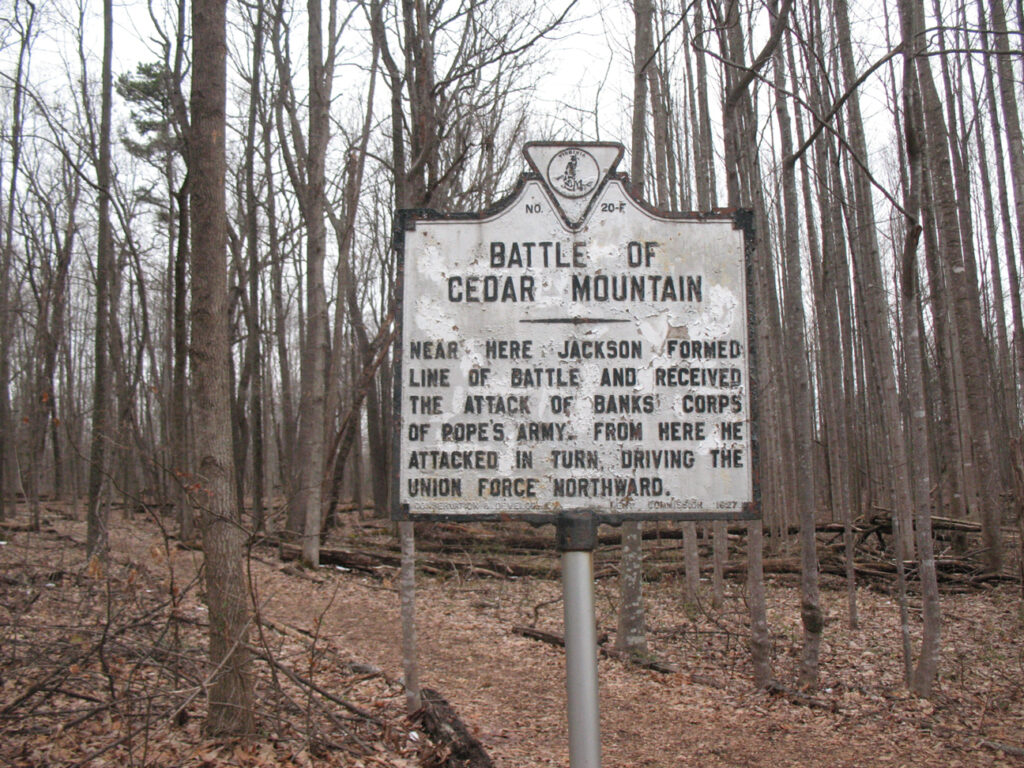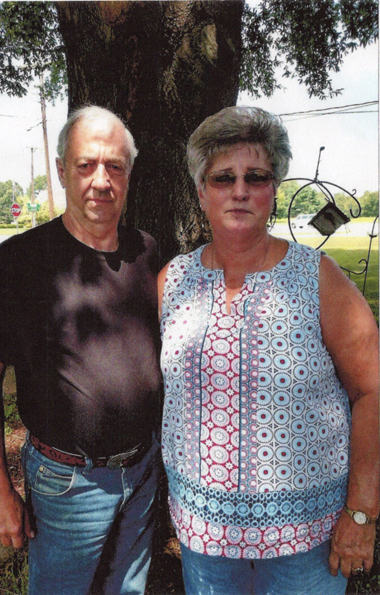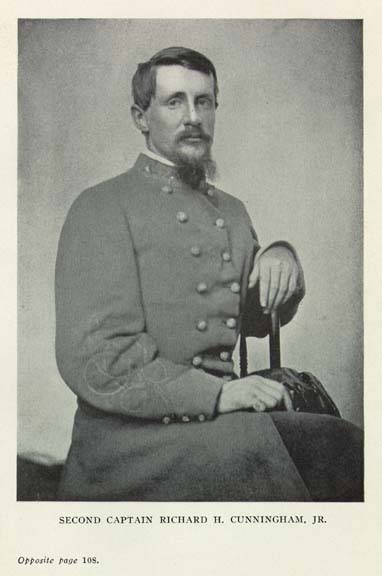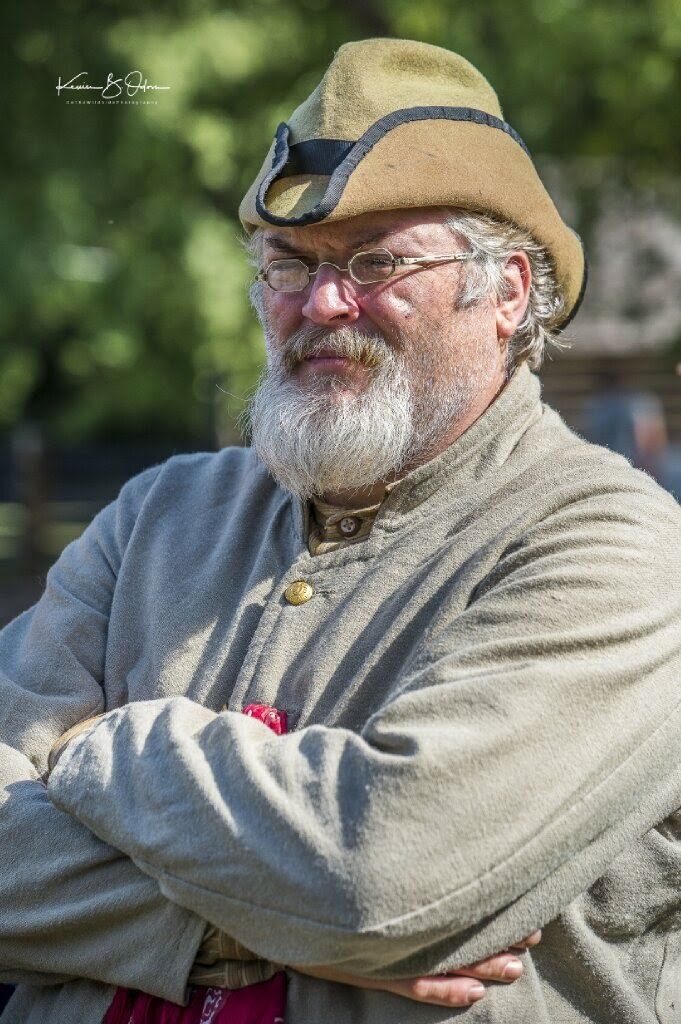Friends of Cedar Mountain Battlefield (FCMB) welcomes requests for battlefield tours by individuals or groups seeking to learn more about the battle. FCMB was delighted to respond to a request by Mr. Mike Dove for a private tour in August 2018. Board member Bradley Forbush provided the tour and wrote this tour report.
Mike Dove had traveled to Cedar Mountain several times in the past, but those trips were before a crucial portion of the battlefield was preserved by American Battlefield Trust.
On those previous visits, only a solitary sign on the side of route 15 indicated the Battle of Cedar Mountain happened “near here.”

In 2018 Mike contacted Friends of Cedar Mountain Battlefield and scheduled a guided tour of the field. He and his cousin, Kay, drove up from North Carolina for the battle’s 156th anniversary weekend on August 10, 2018. For the first time Mike retraced the footsteps of three of his ancestors, present at the battle on August 9, 1862.

Five of Mike’s ancestors served in the 21st Virginia Volunteer Infantry at one time or another. The first 3 family members to enlist were William J. Dove (about age 29), his younger brother Jackson Green Dove (about age 18) and their brother-in-law John J. Rowland (about age 41). Each man was from Pittsylvania County, Virginia. Their company organized at Chalk Level and was accordingly called the “Chalk Level Grays.” The 3 recruits signed enlistment papers July 1, 1861 in Richmond, and the “Grays” became Company H of the 21st Virginia Volunteer Infantry.
The 21st was sort of a “hard luck” regiment. From its earliest days the men suffered from sickness and exposure. A brief synopsis of their difficult first year of service is provided in a separate post.
The history of the 21st Virginia is closely related to the history of the 3 other regiments of their brigade, the 42nd Virginia, 48th Virginia, and 1st Virginia (Irish) Battalion. This brigade, under the command of Colonel Thomas S. Garnett, fought at Cedar Mountain.
At the Cedar Mountain engagement, Garnett’s brigade happened to occupy the most deadly position on the Confederate line. The 21st Virginia suffered 37 men killed and 85 wounded. Three of the casualties were members of the Dove family.
Walking Tour of Cedar Mountain Battlefield, August 10, 2018
Walking in the footsteps of your ancestors leads to powerful emotions. During the anniversary weekend of the Battle of Cedar Mountain, Mike was retracing the last moments of his great-great grandfather’s life.
Mike was familiar with the memoir of John Worsham, a member of Company F, 21st Virginia. One incident in particular from Worsham’s narrative stood out in Mike’s memory. Worsham wrote:
“Our division was hurried along the road some distance, the Second Brigade marched to the front of the column and halted, the roll was called, we were ordered to load, and, after a few minutes of rest, we resumed the hurried march. Going a short distance, the men on the left of the road cleared the way for a cannon ball that came bounding along like a boy’s ball.
The force with which it was traveling is indicated by its striking the stump of a tree, glancing up, and going out of sight. A little farther on we came to four of our men lying in the road dead, killed by this same ball. The road was fairly alive now with shot and shell from the enemy, and we filed to the left into the wood, went about one hundred yards, filed to the right, and continued our march, parallel to the road.” #1
“Where did that happen?” Mike asked me, as we stood in the battlefield’s meeting house.
“Right outside the door here, on the Old Orange Road in front of the battlefield parking area,” I replied.
The tour proceeded from the meeting house. We followed the Old Orange Road trace past the Crittenden Gate and onto the battlefield proper. After their circuitous advance through woods to avoid enemy artillery fire in the road, the 21st formed at the edge of the trees lining the turnpike.
John Worsham’s narrative continues:
“The Second Brigade [Colonel T. S. Garnett] formed a line of battle in the corner or angle of the wood, the 21st Virginia Regiment on the right, the 48th Virginia next, both facing east, the 42d Virginia. next, and, at right angles to the road facing north, the Irish battalion next, forming the left.” #2
Our tour followed the path of the Confederate line pointing out approximately where it bent back at a right angle into what was then woods, but what is now an open field. At a point across the field the Confederate line ended. Supporting troops were coming, but would not arrive until after a devastating attack swept past the open left flank of the brigade line. The charging Federals turned, and headed through the woods towards the unsuspecting troops lining the road. The attack rolled up that part of the Confederate line perpendicular to the road. Elements of the 42nd Virginia, virtually defenseless with their front at a right angle to the enemy, did what they could to defend themselves in vicious hand to hand combat, but it proved of little use.
Those troops along the road, the 21st Virginia and most of the 48th Virginia, were busily engaged with the enemy Ohioans advancing through the cornfields to their front-left, unaware of the charging force directly behind them.
John Worsham continues, “…As soon as we reached the road, we saw a line of Yankees advancing from the corn field, the 21st and 48th opened fire on them at once; and the battle of Cedar Run had commenced in earnest. We caused the advancing line to halt, and the fighting was terrific.”
While thus engaged, the Federal soldiers in their rear began to trickle, then pour, out of the woods behind the Virginians’ line. The Colonel of the 21st realized what was happening and tried to get his men out of harm’s way.
“A part of the force advancing against the left of the brigade, were firing directly into the flank of the 48th and 21st Regiments, and were making terrible havoc in their ranks. Col. Cunningham of the 21st, who was sick, came along the line, walking and leading his horse, and said to the men as he passed that the enemy are in our rear and he desired to get us out of the position we were in, and we must follow him.
“… After a few steps, I saw a Yankee sergeant step into the road about fifty or seventy- five yards ahead of us, and at the same time heard the firing of rapidly approaching enemy in our rear. … The sergeant, having his gun in his left hand, his drawn sword in his right, turned up the road towards us, and approached. A Yankee private stepped into the road just ahead of him; this being the road on which we marched to get to our position, it shows that the enemy were not only in our front, flank, and rear, but actually had the second brigade surrounded. The Yankee sergeant did not stop his advance towards us until he actually took hold of one of the men of our regiment and pulled him out of ranks, and started toward the rear with his prisoner. One of our men, who was in the act of capping his gun, raised it to his shoulder, fired, and the sergeant fell dead not ten feet away. By this time the road was full of Yankees, and there was such a fight as was not witnessed during the war; guns, bayonets, swords, pistols, fence rails, rocks, etc., were used all along the line. I have heard of a “hell spot” in some battles, this sure was one.
“… Col. Cunningham had crossed the road leading his horse, pulled down the fence, passed through the gap into the field, started to mount his horse, his foot in the stirrup , when he was struck by a bullet, and fell back dead, his horse receiving his death wound at the same time. It was a terrible time, the Second Brigade was overwhelmed, nearly half of the 21st VA. Regt. lay on the ground, dead and wounded.” #3

Among the casualties were Mike Dove’s great great grandfather, Private William J. Dove, killed in action. William’s brother Jackson Green Dove was badly wounded, shot in the left lung; yet he survived the war, even returning to his regiment after his recovery. Their 18 year old cousin William A. Dove was killed at Cedar Mountain.
The day after the battle, after some minor skirmishing in the morning, the opposing sides dis-engaged. Orders came to care for the wounded and bury the dead. On this day, August 10, 1862, one Confederate described the section of the Orange Road where Garnett’s Brigade fought, “so backed up with dead men and horses that it was impossible to follow it.”#4
During our tour the question arose: what became of the Confederate dead buried on the battlefield? The answer is a sad one. The field remains a graveyard to this day.
On August 10 and 11, 1862, “The majority of the Confederate dead were buried tenderly by friends and comrades who retraced their movements for that cheerless purpose.”#5
No matter how carefully or hastily the Confederates were buried by their comrades, the graves are lost.
In 1863, on two separate occasions, Southern soldiers camped near the battlefield took the time to cover up the exposed bones and graves of the Confederate fallen because “hogs had been rooting there.” #6
After the war, in 1868 the remains of 405 Union soldiers were exhumed from the battlefield and re-interred at the newly established Federal Cemetery in Culpeper. Only the remains of one of these was identified, the rest are unknown. There is no evidence extant of the removal of Confederate dead. Their remains are most likely forever mingled with the soil on which they died.
Mike’s great great grandfather William J. Dove was about age 30 when he was killed on August 9, 1862. His wife Susan, with her 3 children — William Henry (age 5), Mary Elizabeth (age 3), and Martha J. (age 2) — moved back to Caswell County, North Carolina where she was born and where her parents still lived. In late August 1864, she was granted a one time payment of $83.30 from the Confederate States government for the loss of her husband.
Friends of Cedar Mountain Battlefield Anniversary Weekend
Friends of Cedar Mountain Battlefield offers guided tours anytime for visitors who contact us in advance, but there are advantages to visiting during our annual event, always the second weekend in August. Several activities are planned, and as Mike Dove learned, you never know who you might meet.
After taking in an artillery demonstration Mike and his cousin Kay chatted with living historian Kevin Dawson. During the conversation Dawson revealed he too had an ancestor in the Confederate army killed at the Battle of Cedar Mountain.
“What regiment?” Mike asked. “The 21st Virginia,” replied Kevin.
“That’s the same regiment!” Mike responded, surprised. “What Company?” “Company H,” Kevin replied.
The Dove and Dawson ancestors were in the same Company!
Kevin shared his family’s story with Mike and Kay:
“Our family history says that my great great great grandfather, along with his 5 sons (including my great great uncle, Samuel Templeton) joined the 21st Virginia Infantry, Co. H, “Chalk Level Grays”, out of Pittsylvania County. During the fighting, Samuel was mortally wounded, and when the fighting began to subside, his father and brothers went back and found Samuel leaning against a tree, having been shot in the neck. According to family history, Samuel, knowing he was near death, told his family to tell his mother that he loved her and that he was sorry. He told his father and his brothers to continue fighting, so that his death wouldn’t “be for nothing.” He then held his father’s and brothers’ hands and slipped away.”#7

In all, it was a memorable visit for Mike and Kay, and they plan to return to attend the anniversary weekend in 2019. The Friends of Cedar Mountain Battlefield were pleased and honored to make their acquaintance and happy to provide the tour.
A late afternoon memorial service closes the anniversary weekend events. A list of names of soldiers present at the battle, provided by descendants of those soldiers, is read aloud to the gathered crowd. A bell rings out for the names of those mortally wounded or killed. In 2018 the names of William J. Dove and William A. Dove were added to the list.
If you are interested in a guided tour of the battlefield or a customized tour similar this experience, please contact the Friends of Cedar Mountain Battlefield at 540-727-8849 or [email protected]
NOTES
- John Worsham. One of Jackson’s Foot Cavalry, Neale Publishing Company, New York, 1912. p. 110-111.
- Worsham, p. 111.
- Worsham, p. 111-114.
- Robert K. Krick, Stonewall Jackson at Cedar Mountain, UNC Press, Chapel Hill, 1990. p. 339.
- Krick, p. 340.
- Krick, p. 388-392.
- The roster in author Susan A. Riggs History of the 21 VA, (H. E. Howard Publisher, Lynchburg, VA, 1991) lists the following members of the Templeton family in Company H.
Templeton, James R. Enlisted July 1, 1861 in Pittsylvania in Company H as Private. Wounded flesh July 1864. Listed AWOL November-December 1864 (final roll).
Templeton, Robert A. Present from November-December 1861. Company H Sergeant. Then to Private. To Corporal August 31, 1862. To Sergeant November 1, 1862. AWOL. To Private January-February 1863. KIA May 3, 1863 Chancellorsville.
Templeton, Samuel; Father John Templeton. Enlisted July 1, 1861 in Pittsylvania County in Company H as Private. KIA August 9, 1862 Cedar Mountain.
Templeton, William E.; Enlisted July 1, 1861 in Pittsylvania County in Company H as Private. AWOL and arrested. POW May 20, 1864 Spotsylvania Court House. (Point Lookout). Joined U.S. service June 15, 1864.
Templeton, William H.; 5’9 1/2”, dark complexion, brown hair, blue eyes. Resident Greenhill, Campbell County. Enlisted July 1, 1861 in Pittsylvania County in Company H as Private. POW April 6, 1865 Burkeville. Oath and released June 2, 1865.
ADDENDUM
Members of the Dove Family who served in the Confederate Army
21st VA Company H:
Dove, William J. Age about 30 at time of death. (b. between 1832 – 1839 though 1850 census and his widow’s age suggest 1832 is correct). KIA Cedar Mountain. One of 7 children, was born in the 1830s in the foothills of the White Oak Mountain on Magoty Creek in Pittsylvania County, VA. He married Susan A. Strader on March 25, 1853 in Caswell County, NC. In 1860 he was living in Pittsylvania County. Left widow Susan A. Dove and 3 children, William Henry, age 5, Mary Elizabeth, age 3, and Martha J., age 2. His widow moved back to Caswell County, NC where she was born and where her parents still lived. In late August, 1864, she was granted a one time payment of $83.30 from the Confederate States government for the loss of her husband.
Dove, Jackson Green (brother of William J. Dove). 5’11 1/8”, dark complexion, dark brown hair, dark hazel eyes. Resident of Pittsylvania County. Company H. Wounded August 9, 1862 at Cedar Mountain. Court-martialed March-April 1863. POW September 25, 1864 Harrisonburg (Point Lookout). Oath and released June 11, 1865. [Age 18 or 19; b. 1843 – 1844/ source = 1850 census.]
Dove, William A. (cousin to William J. Dove & Jackson Green Dove). Son of George A. P. Dove who also served in 53rd Virginia. Age 18 when KIA at Cedar Mountain.
Rowland, John J. Father John Rowland. Enlisted July 1, 1861 in Pittsylvania County in Company H as Private. Died January 31, 1862 in Winchester. [Probably exposure from Romney Campaign – BF] Age about 42 at time of death. 1850 census gives his age at 31, (b. about 1819 which corresponds with the birthdates of his siblings. His mother, Nancy Tucker is born about 1791).
Shelton, Nathan Frank. Born December 22, 1827, 5’10”, dark complexion, dark hair, dark eyes. Resident of Pittsylvania County. Farmer. Enlisted March 10, 1862. Company H. Private. Court martialed August 3, 1862. Shoemaker January-February 1864. Wounded. Minie ball March 25, 1865 Fort Stedman and POW April 25, 1865 Petersburg or April 6, 1865 Farmville (Newport News, Fairground Post Hospital, Petersburg). Oath July 1, 1865. Some discrepancies in record. (Brother-in-law to William J. Dove and Jackson Green Dove). [Nathan Frank Shelton lived to be aged 77. He died January 21, 1907; buried in Shelton Cemetery, Pittsylvania County; source Find A Grave).
Other Regiments:
Thomas H. Dove (brother to William J. and Jackson Green). Enlisted on February 14, 1862 in Motley’s Company 1st Regiment Virginia Light Artillery. Died July 19, 1862 in CSA Hospital at Danville, VA of typhoid fever. He was about age 37 at the time of death. Born about 1825; source: Virginia Deaths and Burials, 1853 – 1912. Index. Family Search, Salt Lake City, Utah, 2010; index entries derived from digital copies of original and compiled records.
George A. P. Dove (father of William A. Dove, cousin to William J. and Jackson Green Dove). George served in the 53rd Virginia. Record not on hand.
 Print This Post
Print This Post

